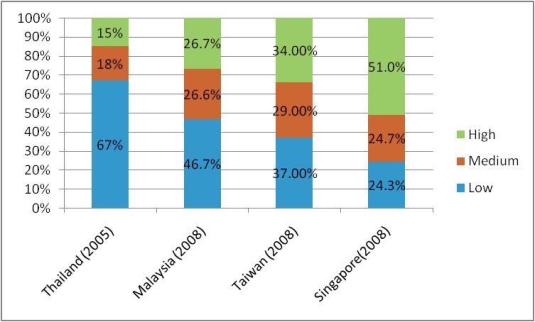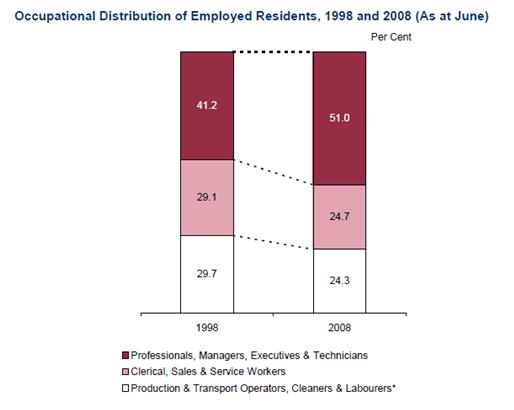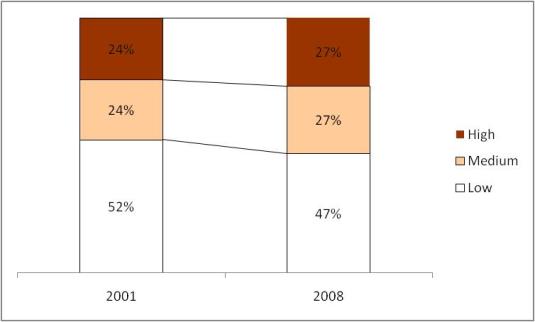The following is written by our reader klm, in response to my article “Can webecome a high income country?” which can be viewed here.
………………………………………………………………………………….
Can Malaysia be a high income country? A Macro view of jobs and labour .
By KLM, Economist Burok.
What is a high income country? The World Bank definition is : Income group: Economies are divided according to 2008 GNI per capita, calculated using the World Bank Atlas method. The groups are: low income, $975 or less; lower middle income, $976 – $3,855; upper middle income, $3,856 – $11,905; and high income, $11,906 or more.
How to get there? Go up the value chain, knowledge industry etc. The strategy is well known and discussed.
But what does it really mean. One way of looking it is to view from the point of jobs and compare it to other countries.
Comparison of Income Groups By Countries
High income countries have a labour profile of at least a third of more if its population in high income jobs and a third or less in low income jobs. Singapore is the extreme end of this profile with 51% of its population in the high income occupations. This occupation distribution changes according to the classification of the country.
Occupational Distribution By Countries
High Income : Senior officials, Professionals, Managers, Executives & Technical workers
Medium Income : Clerical, Sales & Service Workers
Low Income : Production & Transport Operators, Cleaners & Labourers
| Thailand | Malaysia | Taiwan | Singapore | |
| Classification | Lower Middle Income | Upper Middle Income | High Income | High Income |
| GDP/Capita(2008) | 4,400 USD | 8,324 USD | 18,966 USD | 44,113 USD |
Distribution of occupations by population
Singapore
Singapore saw a rapid change in the distribution of occupations, especially in the high income jobs, with 51% of the population in the high income job category , the highest in the developed countries. The change is fueled by migration of knowledge workers from Malaysia and other countries.
Malaysia
The changes in the distribution of occupations in Malaysia is moving slowly. This is an indication of the lack of structural changes in its industries reflecting in the slow demand for knowledge workers. This is already well known issue. Slow demand and low pay for knowledge workers led to migration of these workers to other countries – the Malaysian brain drain problem.
Occupation Distribution of Employed Residents 2001 to 2008
Conclusion
It is obvious that to become a high income country, the distribution of occupations need to evolve with more than a third of the population in high income jobs. This requires industries that use more knowledge workers and the ability to supply high quality knowledge labour. It was reported that Penang Chief Minister Lim Guan Eng told Parliament recently that the state lost US$3 billion (RM10.2 billion) worth of foreign investment because it could not “commit to having 1,000 engineers”.
Recently the PM had acknowledged the fact that Malaysia had achieved success in the past by growing an industrial base and expanding its agricultural sector, he emphasised that more measures were needed to boost the economy and that the country can no longer rely on what had worked in the past.
What mix of high , medium and low income occupations is a question for the New Economic Model of Najib.
……………………
An excellent article backed with facts and figures. Thanks klm. 🙂






Nov 11, 2009 @ 12:19:50
klm,
A most commendable effort. Easily comprehensible, even to the layman. One thing about using Singapore as an example; its small population and migrant labor practices tend to skew reported statistics. High income skilled migrant workers tend to be included in statistics as resident ( most are PR ); low income low skilled migrant labor mostly are not (non-PR, including daily commuter-workers from Johore ). Perhaps that is a factor in Singapore’s reported 51% high income population. Partly caused by a statistical anomaly.
LikeLike
Nov 11, 2009 @ 12:28:30
excellent research by KLM, thanks!
LikeLike
Nov 11, 2009 @ 12:59:24
clearwater. Agreed.
This is same problem with statistics from Luxembourg in Europe. It is small like Singapore. About 30% of workers do not live there.
And Luxembourg has the highest GDP/capita – 113K USD.
One way to solve the problem is to send out the low income group of workers out of the country every night. Then the GDP statistics will be fantastic. Hey. Maybe I can sell this idea to the KPI Minister. 🙂
LikeLike
Nov 11, 2009 @ 13:02:38
Singapore’s workforce is fueled mainly by high performance workers and the first of many waves of such workers came from Malaysia. To date, we have had several Chief Justice and high ranking government officials in Singapore who were Malaysians. Even the current batch of MPs contain several Malaysians amongst whom are Dr Khaw Boon Wan and Ms Irene Ng, both of which are from Penang, if my memory serves me correctly. The focus of Singapore immigration policies have now shifted to include India and China and are less dependent on Malaysia.
I, for one, am from Penang and have lived in Singapore for over 20 years. Would I go back to Malaysia to serve my home country? No way. It was the policies (think NEP) of the government that forced many of us to seek greener pastures in this small island.
Among my cohorts (numbering more than 30)whom have “fled” to Singapore, I would say nearly 95% are categorized as being in the High Income group. One or two have converted to being a Singaporean. We have several doctors, a large number of engineers and a few lawyers. And this is just within our batch of scoolmates who left Penang in 1989.
Would it have benefited Malaysia if we had stayed behind? It would be difficult to say as most of us would probably not have enjoyed the privilege of furthering ourselves.
Malaysia has only itself to blame for lagging behind its neighbours. Without the removal of NEP and its other racial based policies, it would slowly sink. Most of the university graduates from Malaysia that I have come across are only of mediocre standards, and some could not speak proper English. The flip flop on the use of English would continue to be a barrier for Malaysia to grow.
Personally, I encourage my younger cousins to move out of Malaysia if the opportunity arises as I see no future for non-Bumiputras in Malaysia.
@ Clear water,
In macro economics, you would still take into account the contributions of migrant workers as they contribute to the growth of the country and thus the GDP.
LikeLike
Nov 11, 2009 @ 13:04:51
Thanks KLM, well done. However I doubt the figure of Singapore income, USD44,113, a bit too high, it should be around USD38,000.
Anyway, thanks for your effort.
Thumb up.
I have published this article in my facebook too http://www.facebook.com/note.php?saved&&suggest¬e_id=189634321944
LikeLike
Nov 11, 2009 @ 13:38:50
klm,
Just make sure that you post this fabulous and analytical article to our No.1 Finance Minister’s blog since he had invited ideas from the public, the so-called constructive ones he would have listened!
Do it, and joke aside, this is damn good piece!……
LikeLike
Nov 11, 2009 @ 14:54:57
Desmond is right to say that contribution of migrant workers make up a portion of our country’s GDP growth. Their take home pay is much higher than some of our local citizen especially those dispatch boy, lower grade civil servant and clerical staff. This especially true to those migrant construction workers. further to that, they are more hard working than locals. we can safely say that Indon construction workers contribute much more than “some” if not “most”of locals.
China managed to double their Gross National Income once every 10 years for the past 20 years by achieving annual GDP growth of around 10% and it is now finding it difficult maintain the pace. In the process, massive urbanization took place couple with massive production of high quality graduates. That is the initialization of the high value chain economy. Until and unless we took a serious look into our education system, the result is already written on the wall. No guessing needed. Do away with the religion and race dictated policy as proven time and again in so many countries to be a fallacy.
LikeLike
Nov 11, 2009 @ 21:06:00
I am sure KLM posting would make some ministers red faced.
Thanks
LikeLike
Nov 11, 2009 @ 21:28:18
Hey klm,
Can i seek your permission to put this article on my blog?
Copy cat lah, ok?
LikeLike
Nov 11, 2009 @ 21:50:47
klm,
A good effort of yours, but to those goons who are not good in figures, who can’t even spot mistake of 6% or 9% growth, he will say, so what? So long if I am of the high income group, I already a “Developed Man” long long ago. Who cares about the rest. Who cares Malaysia will not be a “Developed Country” by 2020.
To me, I don’t really care whether Malaysia will achieve a high income country. What is the use of having high income but with low disposable income? Many are facing tough time in Singapore, Japan or Taiwan with their relatively ‘high’ income.
To sustain an economy for long-term basis, productivity is the key. Absolute figure by itself can be very misleading. Many in Indonesia are “millionaires” but they are still very poor.
LikeLike
Nov 11, 2009 @ 22:45:28
frank. Go ahead.
LikeLike
Nov 12, 2009 @ 00:09:44
AtM. I agree with you. If there is a high percentage of low income, the govt is forced to keep the cost of living low at least for basic items. This is where subsidies come in.
The suppression of prices actually improves the disposable income of the high income group. That is why Malaysian can still afford maids. Removing the subsidies without improving income will cause an overthrow of the govt.
As long as this structure is maintained, I will find life here easier.For selfish reason, I would like to keep it this way. 🙂
LikeLike
Nov 12, 2009 @ 02:13:13
This book is a must read if you are a layman and interested in understanding Malaysia’s budget which shapes the country from a macro-economic point.
Title: The Budget – How the Government is spending OUR money
Author: Teh Chi-Chang
Book cost: RM20/-
LikeLike
Nov 12, 2009 @ 09:38:37
Yeongws. GDP figures vary with the source and the method. The one in the chart was sourced from a comparison table done by Taiwan Investment Board.
Below is the figures from IMF. It is the nominal GDP/Head.
Malaysia : USD 8,141
Singapore : USD 38,972
I noticed economists never give straight answer. Even for GDP, there are so many answers. They also say on one hand this, and then on the other hand that. If you want to hire an economist, hire one with one hand. Then you get one answer.
If there are any economist who read this, my apology. Just cannot resist the dig. All in good fun. 🙂
LikeLike
Nov 12, 2009 @ 09:40:34
romerz. I saw the book in the shop. But I was too cheap skate to buy. I think I get it.
LikeLike
Nov 12, 2009 @ 10:27:40
KLM’s excellent piece has spark off a lively debate here on Dr. Hsu’s blog. Those of us who understand a bit more on economics and numbers will all agree that M’sia will never be able to achieve our goal of joining the first world by 2020. It was a good GOAL first envisioned by TDM but we lost our way when we were led by that useless AAB who slept through his entire wasted 9 years. Now Najib has taken over and the Nation will be better off in this economic race. But no Nation has stayed still. Many 3rd world countries has grown in leaps and bounds the last decade. Witness Vietnam, India and Indonesia. The economic race is getting tougher. Our leaders need to convene more think tanks and more ocnferences and get ideas on how best to jump start our slowing economy. There are no easy answers/solutions. This is the same for many companies when we compete against global giants. While we try to increase our Nations Wealth, we should not abandon our Morality and Humanity, both of which are lacking in this Administration. The premature closure of Lingam’s case and the slow-progress over Beng Hock’s death are causes for concerns indeed.
LikeLike
Nov 13, 2009 @ 10:16:46
Hi Dr Hsu
After a better govt takes office (I’m being partisan here!), Malaysia can attract back a significant number of talent who have emigrated.
Even better if Malaysia recognises dual citizenship
i.e. make it easy for ex-Malaysians to regain their citizenship. Another alternative is to make it easy for ex-Malaysians to gain Malaysian permanent resident status.
LikeLike
Nov 13, 2009 @ 11:17:24
Phua Kai Lit
We should be more open minded and grant PR to those exMalaysians who can contribute here.. After a few years of pR, let them apply for citizenship.
Weshould also extend this to any foreigners in the skill categor, not the Indon or Bangla on Myanmar foreign workers who are running our hawker stalls now..
This is the globalised era, and people move to where they feel is best for them. The movements of people have never been as great as now…from regions to regions, from countries to countries.
Those countries that pratice isolation policies (or near isolation policies where they put a lot of hurdles for expatriate to get pR) will be marginalised sooner or later.
It is no longer 1960s but we are still practicing as if the world is still in the 60s and 70s..
LikeLike
Nov 13, 2009 @ 16:19:30
Read this article Made in Malaysia — Tay Tian Yan, in MI. It is funny and it makes the point.
LikeLike
Dec 24, 2009 @ 11:09:15
Klm,
Thanks for an interesting article. the charts look interesting and easy to understand. Could you share with me the source of it? TQ
LikeLike
Jul 21, 2013 @ 16:55:10
KLM,
i’m lim,as student from utar doing for final year project titled” economic and political problems arising from influx and employment of foreign labour in construction industry malaysia.”
How the foreign labour contributions of migrant workers as they contribute to the growth of the country and thus the GDP.? Can give explain?
LikeLike